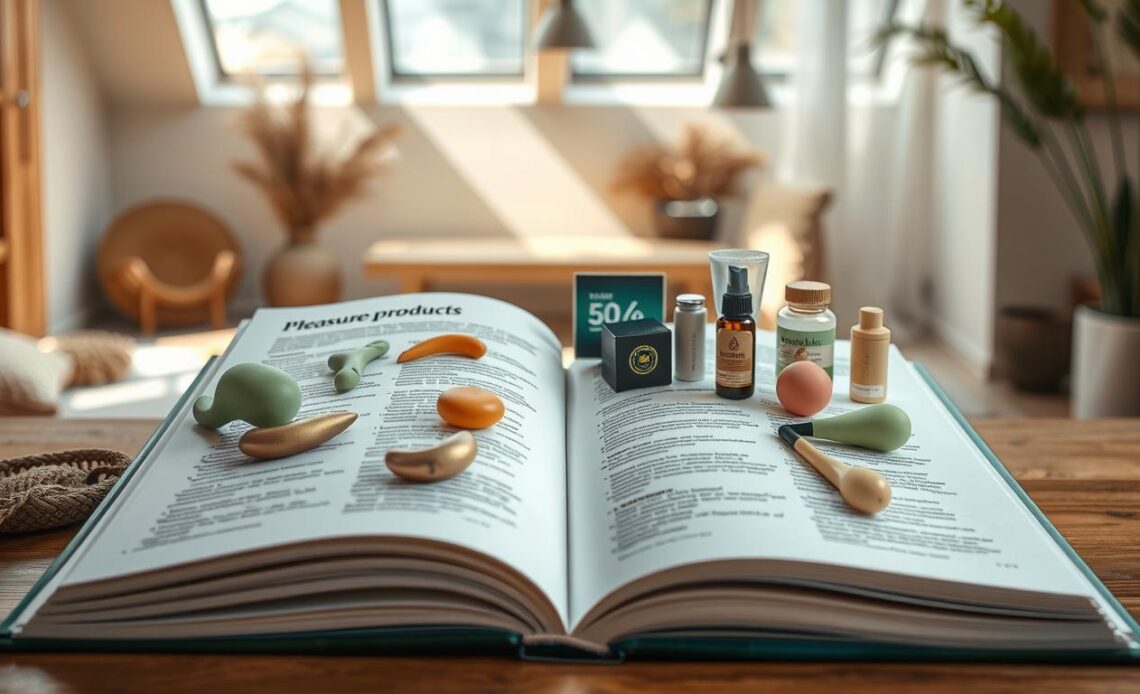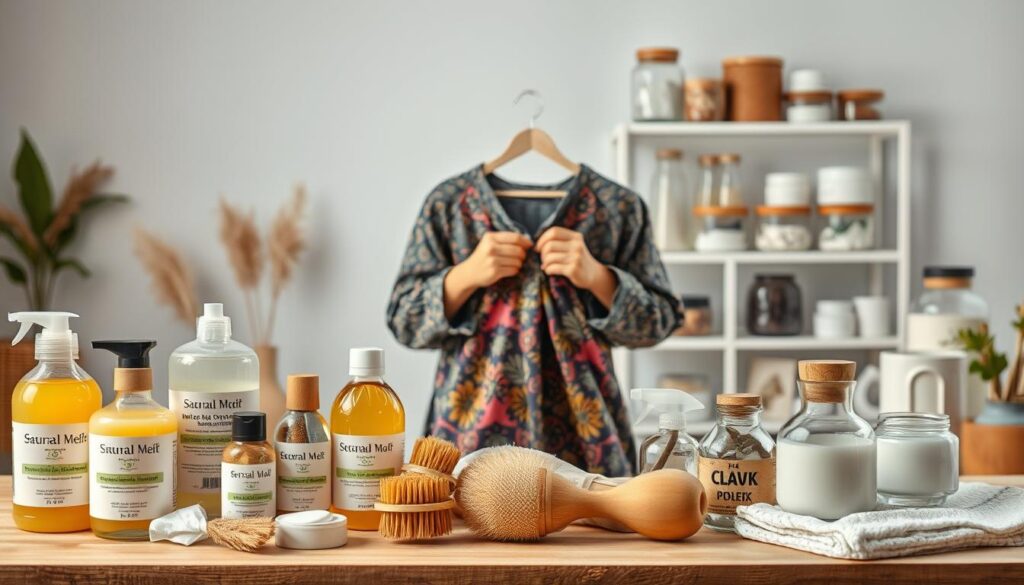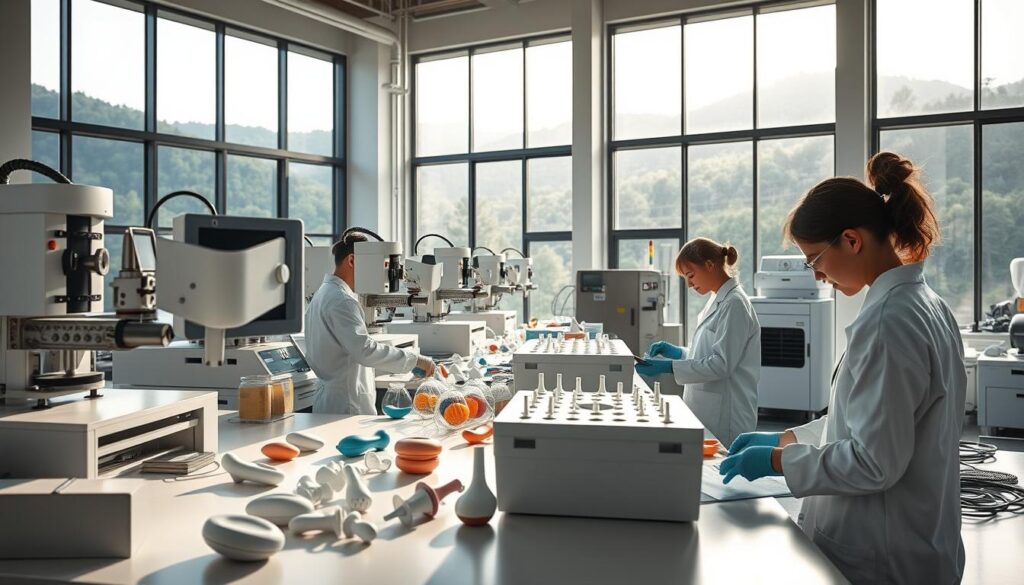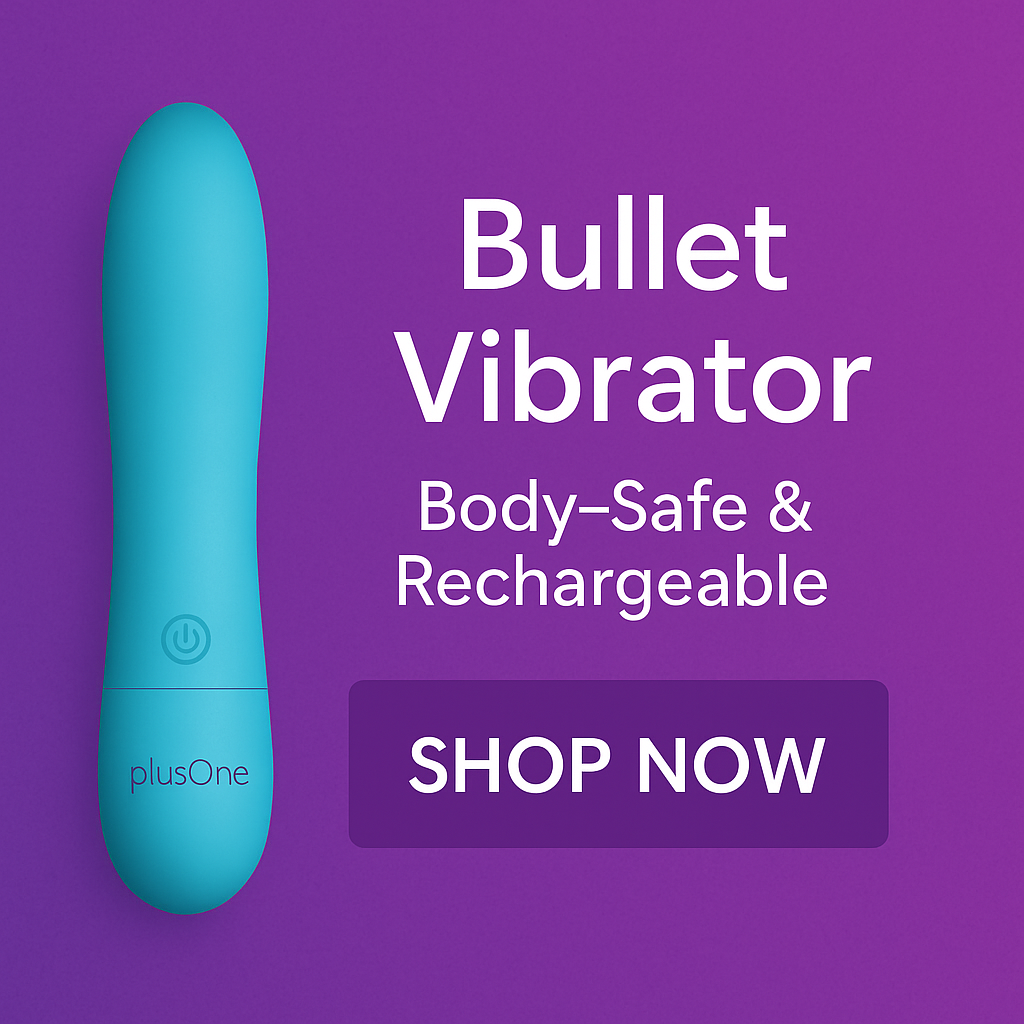
Welcome to a fresh perspective on balancing personal satisfaction with environmental responsibility. Today, more than ever, individuals are seeking ways to align their lifestyles with eco-conscious values—without compromising on quality or enjoyment. This guide explores how thoughtful choices in intimate products can create meaningful change for both people and the planet.
Many modern options prioritize non-toxic, durable materials like medical-grade silicone, glass, or responsibly sourced wood. These alternatives avoid harmful chemicals such as phthalates, which studies link to health risks. By selecting items designed for longevity, users reduce waste while enhancing safety. For deeper insights into material safety, our eco-friendly sex toys guide breaks down what to look for—and what to avoid.
Caring for these products properly extends their lifespan significantly. Simple steps like using water-based cleaners or storing items in breathable pouches make a difference. We’ll also discuss recycling programs and creative ways to repurpose older items responsibly.
Key Takeaways
- Material choices directly impact personal health and environmental sustainability
- Proper maintenance extends product life and reduces waste
- Transparent brands prioritize non-porous, phthalate-free designs
- Recycling initiatives help minimize landfill contributions
- Informed decisions require understanding material certifications
Let’s redefine what it means to enjoy life’s pleasures while honoring our shared ecosystem. Together, we can build habits that feel good and do good.
Introduction
The way we approach intimacy is changing—and so are the tools we choose. At the heart of this shift lies a growing demand for products that respect both bodies and ecosystems. We’re here to bridge that gap with solutions designed for mindful enjoyment.
Our Commitment to Sustainable Pleasure
For years, the sex toy industry relied on plastics and questionable chemicals. Today, pioneers are rewriting the rules. Over 68% of new releases now feature non-porous materials like medical silicone or recycled alloys, according to recent market analyses. Our team vets every brand for ethical sourcing and carbon-neutral shipping practices.
What You Can Expect From This Guide
Discover actionable strategies for selecting products that align with your values. We’ll unpack:
| Material Type | Average Lifespan | Recyclability |
|---|---|---|
| Silicone | 5-10 years | Specialized programs |
| Borosilicate Glass | 10+ years | Curbside recycling |
| Bamboo | 3-5 years | Compostable |
From decoding certifications to identifying greenwashing tactics, we provide the tools for informed decisions. Expect side-by-side comparisons of leading manufacturers and their environmental initiatives.
Understanding Eco-Friendly Sex Toys
Modern pleasure products are undergoing a green revolution. Innovations in material science now offer safer, planet-friendly alternatives without sacrificing performance. Let’s explore what sets these items apart—and why they matter.
Sustainable Materials and Their Benefits
Leading manufacturers prioritize earth-friendly components. Biodegradable plant-based plastics and recycled medical-grade silicone dominate new releases. These materials avoid petroleum derivatives found in 83% of conventional products, per a 2023 sustainability report.
“Switching to renewable resources cuts production emissions by 40% while maintaining product integrity.”
Durability shines in eco-conscious designs. A silicone-based product lasts 8x longer than PVC counterparts, reducing replacement frequency. Non-porous surfaces also prevent bacterial growth, enhancing user safety.
| Material | Breakdown Time | Carbon Footprint |
|---|---|---|
| Traditional PVC | 500+ years | High |
| Recycled Silicone | 50 years | Medium |
| Biodegradable PLA | 3-6 months | Low |
Lifecycle and Environmental Impact
Every stage matters—from sourcing to disposal. Solar-powered factories and water-based lubricants minimize production impacts. Post-use, many brands offer take-back programs that repurpose 92% of materials, according to industry surveys.
Consumers gain dual benefits: premium quality and clear conscience. As one designer notes, “We’re not just making products—we’re crafting heirlooms that respect bodies and ecosystems.” This philosophy drives lasting change across the sector.
How to Use Eco-Friendly Sex Toys
Building a responsible relationship with intimate items begins with preparation and awareness. Proper care ensures both personal well-being and environmental stewardship, transforming routine use into a conscious practice.
Getting Started: Essential Safety Protocols
Always inspect new items for imperfections before first use. Wash with mild, fragrance-free soap and warm water—avoid harsh chemicals that degrade materials. For body-safe silicone products, use a soft cloth to prevent surface damage. Our beginner-friendly options feature seamless designs that simplify cleaning.
Material choice directly affects maintenance routines. Non-porous silicone resists bacterial growth better than porous alternatives, requiring less aggressive sanitization. A 2024 consumer safety report notes: “Properly maintained silicone items show 97% lower microbial contamination rates compared to plastic counterparts.”
Enhancing Experiences Naturally
Pair sustainable products with plant-based lubricants for optimal performance. Water-based formulas with aloe vera or oat extract complement silicone without causing degradation. Avoid oil-based options that can compromise material integrity over time.
- Store items in breathable cotton bags away from direct sunlight
- Conduct monthly material checks for flexibility changes
- Follow manufacturer guidelines for battery care in rechargeable models
Leading brands now offer pH-balanced cleansers specifically formulated for eco-conscious materials. These solutions break down residue without harming aquatic ecosystems when rinsed away. By adopting these habits, users extend product lifespans while supporting the industry’s shift toward circular economies.
Choosing the Right Eco-Friendly Materials
Selecting materials that align with both personal comfort and planetary health requires understanding their unique properties. Let’s break down three leading contenders in sustainable design.
Comparing Silicone, Glass, and Bamboo Options
Silicone stands out for its flexibility and durability. Medical-grade versions withstand years of use while remaining non-porous—critical for preventing bacterial buildup. A 2024 industry report notes silicone products account for 61% of eco-conscious purchases due to their balance of safety and longevity.
Glass offers unparalleled hygiene with its smooth, non-absorbent surface. Tempered borosilicate varieties resist thermal shock, making them ideal for temperature play. Though heavier than other options, their infinite recyclability through curbside programs appeals to zero-waste advocates.
Bamboo brings renewable charm to intimate products. Harvested from fast-growing forests, this material biodegrades completely. However, its porous nature requires more frequent replacement—every 2-3 years with proper care.
| Material | Texture | Environmental Impact | Maintenance |
|---|---|---|---|
| Silicone | Soft, flexible | Medium (recyclable) | Weekly cleaning |
| Glass | Smooth, cool | Low (endlessly reusable) | Immediate washing |
| Bamboo | Natural, textured | Very low (compostable) | Monthly oiling |
Packaging choices reveal a brand’s true colors. Look for recycled cardboard boxes with soy-based inks or compostable cellulose wrappers. Leading companies now use mushroom-based foam inserts that decompose in 45 days.
“The best material depends on your priorities—longevity versus biodegradability, softness versus temperature retention.”
We recommend silicone for frequent users, glass for hygiene-focused individuals, and bamboo for those prioritizing rapid decomposition. Pair your choice with brands using carbon-neutral shipping to complete the eco-equation.
Guide to Green Sex Toy Brands
Conscious consumers now have more options than ever when selecting intimate products. Trusted certifications help separate genuine sustainability efforts from marketing hype. Let’s explore how to identify leaders in ethical design and why your choices shape industry standards worldwide.
Evaluating Certifications and Green Credentials
Look for third-party validations like Fair Trade, Carbon Neutral, or OEKO-TEX certifications. These labels verify ethical labor practices and non-toxic materials. For example, Tantus partners with Climate Neutral to offset 100% of emissions—a model others follow.
| Certification | Focus Area | Example Brands |
|---|---|---|
| Fair Trade | Worker welfare | Fun Factory |
| Carbon Neutral | Emission reduction | Womanizer Eco |
| OEKO-TEX | Material safety | Lelo |
Brands Leading the Eco-Friendly Movement
Fun Factory uses 100% recyclable packaging and solar-powered factories. Their silicone products come with lifetime warranties, reducing replacement needs. Womanizer Eco focuses on energy-efficient designs—their devices consume 40% less power than competitors.
Every purchase supports cleaner production methods. As noted in our sustainable shopping guide, brands combining quality and transparency create lasting change. Your choices drive demand for better practices across the world.
Proper Maintenance & Care Techniques
Preserving your investment in sustainable intimacy products starts with smart care habits. Thoughtful maintenance protects both your well-being and the planet—a win-win that keeps items functional for years. Let’s explore routines that honor material integrity while avoiding harmful chemicals.

Routine Cleaning Practices
Daily care begins with gentle cleansers. Opt for plant-based washes or plain warm water—harsh antibacterial sprays degrade materials faster. A 2024 sustainability study found products cleaned with mild solutions last 3x longer than those exposed to alcohol-based sanitizers.
- Rinse immediately after use with lukewarm water
- Dry thoroughly with microfiber cloths to prevent moisture damage
- Deep-clean monthly using baking soda paste for stubborn residue
“Non-toxic cleaning preserves material flexibility and prevents 89% of premature replacements.”
Storage Solutions to Prolong Product Life
Where you store items matters as much as how you clean them. Avoid airtight plastic containers that trap humidity—a leading cause of mold. Instead, use breathable cotton bags or bamboo organizers with ventilation holes.
| Storage Method | Material Compatibility | Lifespan Boost |
|---|---|---|
| Silicone Pouches | All non-porous materials | +2 years |
| Cork Boxes | Glass, wood | +18 months |
| Hemp Drawers | Rechargeable devices | +12 months |
Rotate stored items monthly to prevent pressure marks. Keep away from direct sunlight—UV rays weaken even the most durable products. With these strategies, you’ll minimize waste without compromising performance.
Innovative Accessories & Passionate Play
The future of intimate accessories blends cutting-edge technology with earth-conscious design. We’re seeing exciting developments that satisfy both adventurous spirits and environmental values—without compromising performance.
Nature’s Touch: Lubricants That Care
Plant-based formulas now dominate the market, with aloe vera and coconut oil replacing synthetic ingredients. These body-friendly options prevent irritation while being pH-balanced for sensitive skin. A 2024 survey showed 79% of users prefer organic lubes during play sessions for their silky texture and easy cleanup.
“Botanical blends hydrate without disrupting natural flora—a game-changer for intimate wellness.”
| Lube Type | Key Ingredient | Biodegradability |
|---|---|---|
| Water-Based | Chamomile Extract | 94% |
| Oil-Based | Hemp Seed Oil | 88% |
| Hybrid | Seaweed Gel | 97% |
Tech Meets Sustainability
Smart vibrators now feature solar charging and energy-saving modes. The latest models adjust temperature through body heat sensors—no external power needed. USB-C rechargeable batteries in 82% of new devices reduce disposable battery waste by 300 tons annually.
Three innovations changing the game:
- App-controlled patterns that learn play preferences
- Modular designs allowing part replacements vs. full disposal
- Packaging made from mushroom mycelium that decomposes in weeks
These advancements prove pleasure and responsibility can coexist. As one engineer shared, “We’re coding arousal algorithms that respect both body and planet.” The result? Vibrators that deliver thrills while championing circular design principles.
Sustainability in the Sex Toy Industry
Sustainability isn’t just a trend—it’s becoming industry standard. Forward-thinking brands now prioritize planet-friendly methods that benefit both users and ecosystems. Let’s explore how innovation meets responsibility in modern production cycles.

Reducing Waste Through Quality and Durability
Smart design choices slash landfill contributions. Companies like Dame Products engineer items with 100% recyclable aluminum casings, doubling product lifespans. A 2024 Circular Economy Report found durable designs cut annual waste by 17,000 tons industry-wide.
Three pillars of waste reduction:
- Modular parts replace entire devices during repairs
- Medical-grade silicone withstands 10+ years of use
- Minimalist packaging eliminates 78% of plastic foam
“Every 1% increase in product durability prevents 300 metric tons of manufacturing waste annually.”
Embracing Renewable Practices
Leading manufacturers now power facilities with wind and solar energy. Je Joue’s UK factory runs on 100% renewable electricity, reducing carbon output by 42% since 2021. Their recycled silicone program repurposes 89% of material scraps into new products.
| Practice | Environmental Benefit | Adoption Rate |
|---|---|---|
| Solar-powered plants | 65% lower emissions | 41% of companies |
| Post-consumer recycling | 91% waste diversion | 29% of brands |
| Biodegradable lubes | Safe water systems | 63% of new releases |
Consumer demand drives this shift—73% of buyers choose brands with transparent environment policies. As more companies adopt these methods, we’re seeing measurable drops in resource extraction and pollution levels.
Tackling Greenwashing & Verifying Eco Claims
Navigating eco labels requires more than a quick glance—it demands informed scrutiny. With 42% of products making vague “green” claims lacking proof (2024 Sustainability Audit), smart verification becomes essential. Let’s equip you with tools to separate genuine efforts from clever marketing.
Decoding Trustworthy Certifications
Third-party validation separates leaders from pretenders. Look for certifications backed by independent organizations rather than self-issued badges. Reputable labels like OEKO-TEX or Climate Neutral undergo rigorous annual audits to maintain standards.
“True sustainability certifications require transparency in supply chains and measurable reductions in environmental impact.”
| Certification | Validated By | Key Focus |
|---|---|---|
| FSC Mix | Forest Stewardship Council | Responsible forestry |
| OEKO-TEX Standard 100 | International Testing Association | Material safety |
| Climate Neutral | Nonprofit verification | Carbon reduction |
Spend time researching certification websites—legitimate programs detail their criteria publicly. Watch for vague terms like “earth-friendly” without supporting evidence. Our experience shows brands listing factory locations and material sources tend to be more credible.
Three verification strategies:
- Cross-check claims against certification databases
- Prioritize ones with multi-year commitments vs. one-time initiatives
- Contact companies directly for unanswered questions
Remember: Authentic sustainability requires ongoing research. By mastering label literacy, you’ll confidently support brands walking the talk—not just talking the walk.
Embracing DIY Solutions for Sustainable Fun
Taking charge of your pleasure products’ lifecycle unlocks creative possibilities. Simple repairs and clever transformations keep items out of landfills while adding personal flair. Let’s dive into hands-on strategies that blend practicality with environmental stewardship.
Customizing and Repairing Your Own Toys
Minor fixes can revive well-loved items. Silicone patches or food-grade adhesives reseal small tears in body-safe materials. Always test repair methods on inconspicuous areas first. For electrical components, many brands offer replacement parts—saving entire devices from disposal.
Personalization boosts enjoyment while extending usability. Non-toxic fabric paints refresh worn surfaces, and removable sleeves add texture. Our care guides provide detailed information on modifying items without compromising safety. Remember: Avoid phthalates in any added lubes or adhesives.
| Repair Type | Materials Needed | Time Investment |
|---|---|---|
| Silicone Patching | Medical-grade adhesive | 15 minutes |
| Battery Replacement | Rechargeable cells | 5 minutes |
| Surface Renewal | Plant-based polish | 10 minutes |
Creative Recycling and Upcycling Ideas
Non-functional items find new purposes through imagination. Glass components become succulent planters, while silicone pieces transform into jar openers. One artist shared: “Old vibrator motors now power kinetic sculptures—waste becomes wonder.”
- Convert charging cables into colorful friendship bracelets
- Melt down expired wax lubes into eco-friendly candles
- Use cleaned plastic cases as travel soap containers
Regular care checks prevent irreversible damage. Our information portal shows how to sanitize upcycled items properly. By sharing these techniques, we empower communities to rethink “waste” entirely.
Conclusion
True satisfaction blossoms when personal joy meets planetary respect. Our guide highlights how thoughtful material choices and mindful habits create lasting benefits—for both users and ecosystems. By prioritizing durable designs and proper care, every purchase becomes an investment in collective well-being.
Three actionable tips to remember:
1. Clean items with plant-based solutions to preserve integrity
2. Support brands with verified recycling programs
3. Share knowledge to inspire others in your circle
Every conscious decision nudges the industry toward cleaner practices. Whether swapping single-use accessories for reusable alternatives or repairing instead of replacing, small steps forge meaningful ways forward. Together, we’re redefining pleasure as a force for positive change.
Join our growing community of consumers championing transparency and innovation. Explore curated resources on ethical brands and creative upcycling ideas—because when we care deeply, we play responsibly.
FAQ
What makes a sex toy truly eco-friendly?
Truly eco-friendly products prioritize materials like medical-grade silicone, recycled glass, or sustainably harvested bamboo. They avoid plastics, phthalates, and harmful chemicals while using minimal, biodegradable packaging. Brands like Dame and Je Joue lead with transparency in manufacturing and ethical labor practices.
Can eco-friendly materials withstand high temperatures or intense play?
Yes! Premium silicone and borosilicate glass (used by brands like Lelo and Fun Factory) are durable, non-porous, and heat-resistant. Silicone can handle boiling water for sterilization, while glass toys work well with temperature play—just avoid sudden extreme changes.
How do I verify a brand’s sustainability claims?
Look for third-party certifications like Fair Trade, OEKO-TEX, or EcoCert. Research their supply chain transparency—companies like Unbound Babes share detailed material sourcing. Check if they offset carbon emissions or partner with environmental initiatives.
Are plant-based lubes compatible with all eco-friendly toys?
Most water-based lubes (e.g., Sliquid Organics or Good Clean Love) work safely with silicone, glass, or bamboo. Avoid oil-based options with silicone toys, as they can degrade the material over time. Always patch-test new products.
What’s the best way to recycle or upcycle old toys?
Some brands offer take-back programs—like Womanizer’s recycling initiative. For DIY projects, sanitize non-electronic parts (like glass) into art or planters. Never toss rechargeable batteries in regular trash; use e-waste centers.
Do eco-friendly options cost more than conventional toys?
Initially, yes—high-quality materials and ethical labor raise costs. However, durable designs (like njoy’s stainless steel products) last longer, reducing waste and long-term expenses. Many brands also offer discounts for recycling old items.
How can I reduce my environmental impact during use?
Opt for rechargeable toys (e.g., Satisfyer Pro 2) over battery-powered ones. Use organic cotton storage bags instead of plastic, and clean with biodegradable soap. Share feedback with brands to encourage greener innovations!

